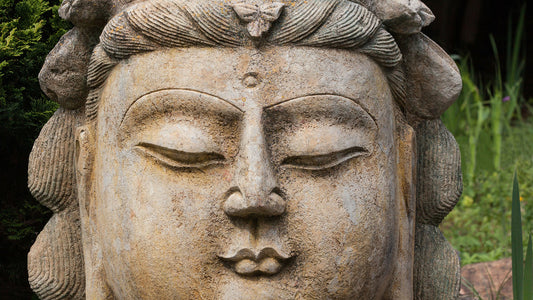
Set-Offers
Save when you buy a set
Shopping cart
Your shopping basket is empty
Yoga

Meditation
Bundles

| Achtsamkeit
As you begin to delve into the subject of meditation, you will encounter some expressions that may at first simply raise question marks in your mind. Don't worry - we'll bring order to the jungle of terms! In general, meditation comes from the Latin meditatio "to ponder, ponder, ponder" and denotes different variants of mental and spiritual exercises.
Today we will briefly explain the most important meditation terms to you!

Mindfulness, Sanskrit smrti , is an expression that was coined by Buddhism in the West. It describes a general, attentive basic attitude that you can practice in a wide variety of activities. The goal is to be aware of the present moment. When you practice mindfulness, acceptance is a key element. You observe your body, your feelings and thoughts without evaluating or analyzing, without letting yourself be carried away by the present moment. Regular mindfulness practice will help you become more aware of your sensations and get to know yourself better. This is how you get off the autopilot of your everyday life into a more conscious, active perception of your life and at the same time you feel more calm and satisfied. Buddhism also has its own mindfulness meditation called Vipassana, and Jon Kabat-Zinn's MBSR method is also based on mindfulness practice.
Bodhi means "awakening" or "enlightenment" in Sanskrit and comes from the same root as the word Buddha - "the awakened one". A Buddha is someone who has broken the cycle of suffering through his own strength, who has attained a perfect, pure mind and thereby attained the fullest realization of his potential. Bodhi is not a quick, punctual event, it is much more a state that occurs gradually through long, regular meditation. The term is also used as a synonym for the Bodhi tree, the poplar fig, under which the Buddha Siddharta Gautama found enlightenment.
The chakras are a concept from tantric Hinduism and also from individual Buddhist currents. They describe seven subtle energy centers in your body. The Sanskrit word cakra means "circle, wheel, discus." The chakras are located along your spine, just like your central nerve canal. Different aspects as well as flowers, colors, symbols and sounds are assigned to the individual chakras and they have an equal effect on body and mind. When all chakras are "open" and harmonized, the state of enlightenment occurs. In meditation you can concentrate on the 6th chakra or the "third eye", the area between the eyebrows, for example, as this is supposed to create a particularly strong focus.
This is a central term in many religions in Southeast Asia, describing law, law or custom, but also ethical/religious obligations. On the one hand, the cosmic dharma, the order of the universe, but also the personal dharma, the life task, can be considered. Both regulate the life of believers in both public and private space. Here too, depending on the religion (Hinduism, Buddhism and Jainism), different interpretations and forms apply. Your dharma can also be your calling, regardless of religion.
You probably already know karma, even if you haven't had anything to do with meditation before. In Sanskrit, this term simply means "effect" or "deed". It describes a cause-and-effect principle that states that every mental and physical action you do has a consequence. In the imaginary world of Hinduism, Jainism and Buddhism, these consequences can also only become visible in later life, since the belief in rebirth is widespread in these religions. You can create good or bad karma, with the goal being to stop accumulating karma at some point.
A mantra is usually a rather short formulaic sequence of words or syllables. It is often holy words or divine names whose qualities should manifest themselves in your life through repetition. Mantras can be thought, sung or spoken. This meditative application of mantras is also known as japa meditation. There are many different types of mantras and their uses depending on tradition. Originally, a spiritual student was given a mantra by their guru, but you can find a mantra that feels (and sounds) good to you without a guru. Above all, a regular, daily practice of mantras brings a proven increase in your concentration and thus inner peace.
In Buddhism, Nirvana means getting off the wheel of rebirth and suffering through awakening (Bodhi). Contrary to the often accepted opinion that this can only occur in death, according to the Buddha this state can also be reached in life. Nirvana is described as happiness that is independent of external circumstances and emotions. It is the end of attachment, greed and egoism and the beginning of the desireless tranquility of mind so often sought.
Samadhi is a Hindu term and, like Bodhi, describes the perfect oneness or enlightenment that can be achieved through meditation. The term is described by Patanjali in his Yoga Sutras as the final stage of the eightfold path. It is a state beyond waking, sleeping or dreaming, in which your discursive thinking comes to a standstill and you become completely absorbed in the object you have been meditating on.
Zen or Zen Buddhism is a branch of Buddhism that originated in China and spread from there to Korea, Vietnam and Japan. He was heavily influenced by Daoism. In the West, the Japanese Zen terms are mostly used. A central part of this practice is on the one hand zazen, sitting in contemplation or meditation and on the other hand complete concentration even in everyday activities. For this reason, Zen is also called “meditation Buddhism”.

Today we will introduce you to an exciting meditation technique: the meditation on the third eye from yoga. Focusing on the area between the eyebro...
Continue reading
In meditation, the mind falls into deep concentration and accesses that quiet and peaceful mindfulness that is essentially always there. Body and...
Continue reading
There are no comments yet. Be the first to leave a comment!